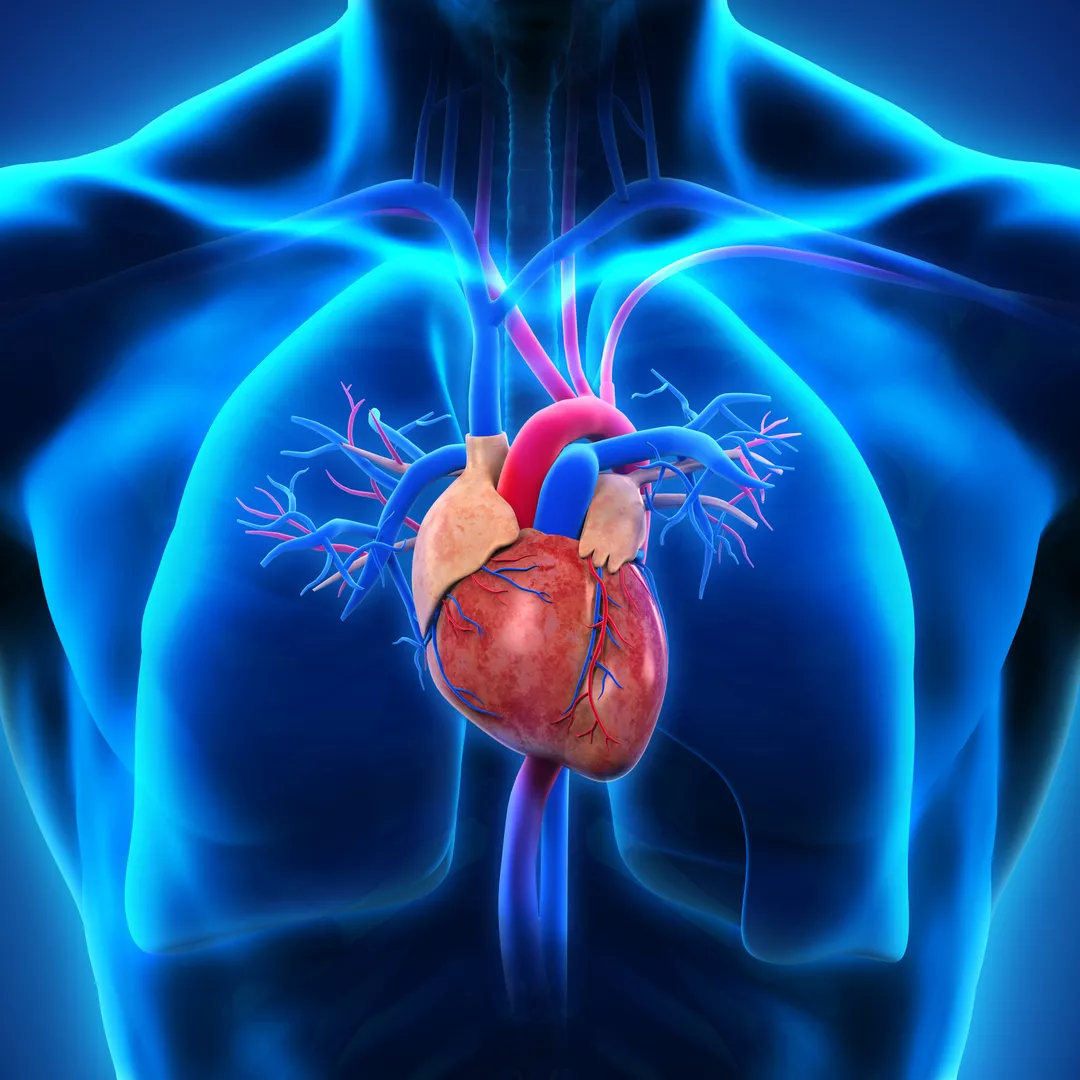What is coronary heart disease?
Coronary heart disease, also known as coronary artery disease, is a common heart condition where the major blood vessels to the heart (coronary arteries) become blocked and narrowed, restricting the flow of oxygen-rich blood to the heart.
Blockages can occur when fat, cholesterol and other substances build up and form plaque in the arteries through a process called atherosclerosis. The plaque can form a blood clot (thrombosis) that interrupts the flow of blood around the body, if it breaks away from the artery wall.
Without enough oxygen, the heart cannot function properly. This can cause chest pain (angina). If a blood clot blocks or stops the flow of blood to the heart, it can cause a life-threatening heart attack.
What is the difference between coronary heart disease and cardiovascular disease?
Coronary heart disease refers specifically to blockage of the coronary arteries by atherosclerotic plaque.
Cardiovascular disease is a broader term covering any disease of the heart or circulatory (vascular) system. The circulatory system consists of all the vessels that carry blood and other fluids around the body. Cardiovascular diseases include heart attack, stroke, heart failure, congenital heart disease, peripheral artery disease and atrial fibrillation.
What is the difference between coronary heart disease and ischaemic heart disease?
The terms “coronary heart disease” and “ischaemic heart disease” are sometimes used interchangeably, but they are not the same.
Ischaemic heart disease is when the heart cannot get enough oxygen to function properly due to a reduced blood supply. Coronary heart disease can lead to ischaemic heart disease, if the coronary arteries become so blocked by atherosclerotic plaque that the heart becomes ischaemic.
Other conditions may cause ischaemic heart disease, such as congenital heart defects, blood clots, low blood pressure and anaemia.
What are the coronary arteries?
Arteries are blood vessels that carry oxygen-rich blood around the body. The arteries that supply the heart muscle are called the coronary arteries.
Any disease or disorder that affects the coronary arteries can reduce the flow of oxygen and nutrients to the heart, and possibly lead to devastating consequences such as heart attack.
The coronary arteries and blood vessels around the heart
What causes coronary heart disease?
The main underlying cause of coronary heart disease is atherosclerosis.
In atherosclerosis, fatty plaques build up on the inner walls of the coronary arteries. These plaques are made up of fat, cholesterol, calcium and other substances. The atherosclerotic plaques harden over time, narrowing the opening of the arteries and restricting blood flow. These plaques can break, forming a blood clot (thrombosis) that can further restrict, or even block, the flow of blood to the body.
The coronary arteries can also be damaged by:
Coronary heart disease often develops over time. Fatty deposits may develop in the arteries during childhood and then thicken and build up as the person ages.
Coronary heart disease symptoms
Coronary heart disease symptoms depend on the severity of the disease. As symptoms can come and go, they may be unrecognised. Some people may experience no symptoms, while others may experience mild to severe ones. Symptoms may also become stronger or more frequent as the disease progresses.
The common signs and symptoms of coronary heart disease include the following.
- Chest pain (angina): If the heart does not receive enough oxygen due to blocked coronary arteries, there may be a feeling of pressure or tightness in the chest. This chest pain normally occurs in the middle or left side of the chest.
- Pain spreading to the arms, shoulder, jaw or neck: These signs and symptoms could indicate a heart attack, which can be triggered by a severely blocked coronary artery.
- Shortness of breath
- Fatigue
Women may experience different symptoms of coronary heart disease to men, such as neck or jaw pain, and nausea.
Coronary heart disease risk factors
There are several factors that increase the risk of developing coronary heart disease. Some of these can be managed or changed, while others cannot.
Coronary heart disease risk factors that can be managed or changed
Coronary heart disease risk factors include:
- High blood pressure: High blood pressure can make the arteries hard and stiff, increasing the risk of atherosclerosis. Medication and dietary changes, such as lowering salt intake, can help to manage it.
- High cholesterol: High levels of LDL cholesterol, the “bad” cholesterol, can increase the build-up of atherosclerotic plaque. Medications to manage cholesterol levels are available, and making dietary changes can also help manage high cholesterol.
- Inactivity: Leading an inactive lifestyle can contribute to being an unhealthy weight and increase the risk of other risk factors like high blood pressure and cholesterol levels. It is also important to stay active after a diagnosis of coronary heart disease, under medical guidance.
- Overweight and obesity: Being overweight or obese can increase the risk of heart disease as well as other risk factors like high blood pressure and high cholesterol. Tips for reaching and maintaining a healthy weight include eating a healthy diet and exercising regularly.
- Diabetes: The risk of developing cardiovascular disease doubles for people living with diabetes. Some dietary changes can help manage diabetes as well as leading a healthy lifestyle.
- Poor nutrition: An unhealthy diet high in saturated fat, trans fat, LDL cholesterol, salt and sugar can contribute to being an unhealthy weight and increase the risk of high cholesterol and high blood pressure. Try to eat a balanced, nutritious diet to support optimal health.
- Smoking: People who smoke have a significantly increased risk of coronary heart disease, as it can increase the risk of atherosclerotic plaque. If you smoke, quitting is one of the best things you can do for your heart health.
- Stress: Long-term stress can damage the arteries and worsen other risk factors for coronary heart disease.
- Alcohol: Long-term alcohol intake can damage the heart muscle and worsen other risk factors for coronary heart disease.
Coronary heart disease risk factors that cannot be changed
- Age: Coronary heart disease becomes more common with increasing age.
- Gender: Men generally have a higher risk of coronary heart disease than women. However, the risk of heart disease for women increases after menopause.
- Family history of heart disease: A family history of heart disease increases the risk of coronary heart disease. The risk is higher if a close relative, such as a parent or sibling, developed heart disease at an early age (before age 55 for a male relative and before age 65 for a female relative).
The impact of coronary heart disease
Coronary heart disease is the most common form of cardiovascular disease. It affects over half a million Australian adults, and it is the leading cause of burden in Australia nationally and within each state.
Coronary heart disease is the underlying cause of 11 per cent of all deaths in Australia, and costs the Australian health system $2.4 billion every year.1, 2
How is coronary heart disease diagnosed?
To diagnose coronary heart disease, your doctor may take a complete family and personal medical history and also conduct a physical exam and blood tests. Other tests may also be administered.
- Electrocardiogram (ECG): This test records the electrical activity of the heart. This can show abnormal heart rhythms and detect damage to the heart muscle.
- Stress test: In this test, the heart, breathing and blood pressure rates are monitored while you are walking on a treadmill.
- Imaging scans: These can include cardiac catherisation and radionuclide imaging. Through different techniques, the structure and blood flow of the heart and arteries can be monitored and visualised, indicating where there are problems such as blocked arteries or damaged areas of the heart.
Coronary heart disease treatment
There is no cure for coronary heart disease, but there are treatment options that can help to manage the symptoms and reduce the risk of further cardiac events, such as heart attack.
Medications may be prescribed by your doctor to treat specific factors, such as:
- antiplatelets to decrease blood clotting
- blood pressure medications to help lower blood pressure, and
- medicines to reduce cholesterol levels.
If the coronary heart disease has progressed such that blood flow to the heart is blocked, surgery may be required to restore blood flow. These procedures include the following.
- Coronary angioplasty: The narrowed artery is widened from the inside by using a special device that is inserted through the groin or wrist and then guided into the artery. A small mesh tube (stent) may be inserted to open the blocked area of the artery and left inside to keep the artery open.
- Coronary artery bypass graft surgery (CABG): A healthy blood vessel is taken from the body and grafted to each side of the blocked artery to redirect blood around (bypass) the blockage and improve blood flow to the heart. More than one bypass may be required to fully restore blood flow to all areas of the heart.
Lifestyle changes to manage coronary heart disease
Positive lifestyle changes can help to manage coronary heart disease as well as reduce the risk of it progressing or developing in the first place. Simple lifestyle changes you can make include the following.
- Eating a heart-healthy, balanced diet low in saturated fats and that includes a variety of fruit, vegetables, wholegrains and healthy protein sources.
- Being physically active to help maintain a healthy weight.
- Limiting alcohol consumption, a risk factor for heart disease.
- Quitting smoking as it can damage the arteries.
- Controlling high blood pressure through dietary choices.
- Lowering cholesterol levels through dietary choices.
Speak to your doctor about what changes may help in your situation.
How is HRI fighting coronary heart disease?
HRI is conducting critical research into coronary heart disease by investigating new ways to prevent, detect and treat the main underlying cause, atherosclerosis, as well as cardiovascular disease as a whole.
Our Cardiovascular-protective Signalling and Drug Discovery Group is investigating how to repurpose existing drugs for next-generation therapies for cardiovascular diseases.
References
- Australian Institute of Health and Welfare; Heart, Stroke and Vascular Disease—Australian Facts. Web report 29 Sep 2021.
- Australian Institute of Health and Welfare 2018. Australian Burden of Disease Study Impact and Causes of Illness and Death in Australia 2015 Summary Report.



